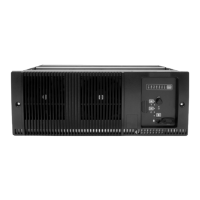80 Operation TB9100/P25 CG/P25 TAG Installation and Operation Manual
© Tait Limited March 2014
Channel Button and
LEDs
The channel button selects which reciter is connected to the control panel.
Repeatedly pressing this button cycles through positions 1 to 7 in the
subrack, regardless of whether the position is occupied. The selection
defaults to position 1 on power-up.
Notice We recommend that you select reciter 1 on the control panel
when you have finished monitoring or configuring a module. This will
prevent false fan failure alarms being raised for the PA and PMU, and will
also allow the remote fan diagnostic test to work.
The channel LEDs have the following states (default settings):
red indicates which is the currently selected reciter
green indicates that the reciter is receiving a valid signal
orange indicates that the selected reciter is currently receiving a valid
signal
These LEDs can display alarm status instead of the state of the Rx gate.
For more information, see “Control Panel” on page 132.
Speaker Button and
LED
The speaker button selects the type of speaker output for the currently
selected reciter. The green speaker LED indicates the type of speaker output.
Refer to “Speaker Operation” on page 82.
Speaker Volume
Button
Controls the volume of the speaker mounted behind the control panel.
Rotate clockwise to increase the volume, and anticlockwise to decrease the
volume.
Speaker The control panel is fitted with a 0.5W speaker. Audio from the base station
can be connected to this speaker.
Receive LED The green receive LED indicates whether the base station is receiving a valid
RF signal.
If the base station is part of a channel group with central voting, the channel
group members must be configured with unique receiver numbers for the
LED to correctly indicate whether the base station won the vote.
LED Description
On (steady) The base station is receiving a valid signal that has won the vote.
Flashing The base station is receiving a valid signal that has lost the vote.
Off The base station is not receiving a valid RF signals.

